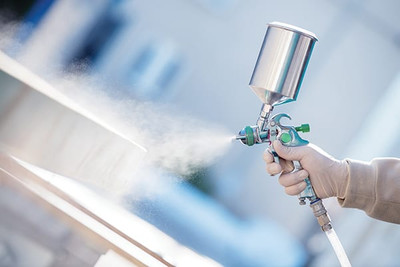Blast cleaning is the term used to describe the process of cleaning, or removing unwanted contaminants, dirt, paint or marks from a surface using water, air or media, propelled under pressure.
Generally speaking, the term blast cleaning is more often used to describe shot-blasting or grit-blasting using abrasive media such as steel shot, grit or other abrasive material. This abrasive is used in air-driven machines - called blast pots - to deliver effective and fast blast cleaning.
It must be noted that the use of sand as a blast media / abrasive is not legal in the United Kingdom and non-silica abrasives must be chosen instead.
Blast cleaning is usually undertaken prior to coating or painting or can be used a stand alone process simply to clean objects and structures.
Commonly in the UK you will hear contractors use the term blast cleaning when referring to brick cleaning or graffiti removal from brick or stone structures. Careful selection of media and air pressure is needed for these surfaces to avoid any structural damage or alteration of the surface profile.
This is also important when considering cleaning other softer surfaces such as wood. If in doubt, please speak to our specialists before undertaking a blast cleaning project to ensure the object or surface in question is not unnecessarily damaged by the blast cleaning process – there are situations where a chemical treatment may be more appropriate.
The term can also be heard in reference to high pressure blasting using water – a common method of cleaning solid floor surfaces. For blasting under high pressure with water, a UHP machine may be utilised.
In addition, blast cleaning is sometimes used to apply a decorative finish to objects and structures, such as artificially aging stonework.
Why is blast cleaning so important?
Aside from the aesthetic results of removing contaminants, good blast cleaning helps prepare surfaces for effective coating. Without blast cleaning, a poor surface condition can negatively impact the coating application resulting in poor paint adhesion or complete coating failure.
Removing rust and corrosion from a metal surface means the surface profile is free of contamination and ready to receive a powder coat or wet paint coat to finish. When a surface is correctly prepared or cleaned, the final finishing coat will perform better and will last longer.
What are the main considerations?
Before embarking on a project, you will need to consider the pressure you will need to blast at. Pressure can normally be adjusted to ensure only the contaminant is removed. Testing a small part of the object prior to undertaking the entire surface is wise.
In addition, you will need to consider the media or abrasive to use for the job at hand. Grit is the most common media used for cleaning under pressure using a blast pot, but there are many different types to choose from. Again, please get in touch with our technical sales team for advice if you are new to blast cleaning. You will also need to consider the grade or size of the grit particle as different sizes will give different surface profiles.
Other media used for blast cleaning can include dry ice, water, calcium carbonate or air. Your selection will depend on the process you are undertaking. Take a look at our media guide to learn more about grades and abrasive types, or read our selection guide on our main website, where you can also find a surface profile poster detailing surface finishing standards.
What equipment will I need for blast cleaning?
Aside from your blast media or abrasive, you will need a range of equipment to propel the abrasive. This is likely to include a blast pot with associated accessories and PPE. Read our guide to shotblasting equipment to find out more.
For more advice, please get in touch with our technical team today.




